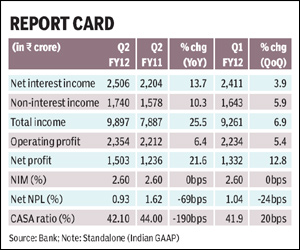Riding the rupee
IT,small car makers,upstream oil firms gain; oil retailers,cars with high import content losers.
With the euro zone engaged in a firefighting exercise to rescue itself from the clutches of a fast-spreading financial crisis and the US witnessing a slowdown in growth,India is,by no means,unscathed. A declining rupee vis-a-vis the dollar is adding to the headache of policymakers,not to speak of companies in various sectors,who are being forced to revisit their targets. Here,we take a look at the impact on various sectors.
IT
 First,the good news. The rupees depreciation against the dollar will help shore up the profitability of Indias export-driven IT services companies during the September quarter,feel industry experts. However,the positive impact could be marginal since most of the 8-10 depreciation came in towards the end of the quarter.
First,the good news. The rupees depreciation against the dollar will help shore up the profitability of Indias export-driven IT services companies during the September quarter,feel industry experts. However,the positive impact could be marginal since most of the 8-10 depreciation came in towards the end of the quarter.
A majority of the billings of large-tier companies happen during the last week of the month the average realisation of a quarter is often the average exchange rates witnessed during the last week of each of the three months in a quarter. For every rupee that depreciates,operating margins for an IT company can shoot up between 30 and 40 basis points.
For the IT industry,it will be a good quarter for profitability to an extent. Most of the depreciation happened towards the end of the quarter. But if the rupee stays at the same level,it would be beneficial in the third quarter, said MindTree CFO Rostow Ravanan. For MindTree,every rupee change positively impacts operating margins by 0.5. The industry,nevertheless,is not sure whether the depreciating trend will continue. The level of volatility is very high and the mood is difficult to predict. Everybody knows about the problems with the US economy and the soaring unemployment,and yet,the dollar is strengthening, Ravanan said.
Ganesh Murthy,CFO of MphasiS,agreed that while rupee8217;s decline will be favourable to the industry this quarter,the trend would not continue for long. In the last two years,whenever there has been a depreciation,it has only lasted 2-3 months. The trend will correct itself. We will be happy to see the rupee in a narrow band about R45-47. We don8217;t want volatility.
Auto
Auto companies with a large import content,such as Honda Siel Cars and General Motors,are expected to take a 2 hit on their margins and,in turn,are expected to hike prices to mitigate the impact of a weakening rupee. The auto industry has been battling high interest rates and fuel prices. Even the outlook on commodity prices,including steel and rubber,remains strong,with no decline seen in the coming months.
In an earlier conversation,General Motors India had confirmed to FE a 2 price increase after the festive season. General Motors imports around 2-10 content on its vehicles from the US,Europe and Korea. Honda Siel Cars India,with large imports from Thailand,Japan and Indonesia,is looking at stepping up its sourcing within India to insulate itself from sharp currency fluctuations in the future. Currently,it has localisation up to 80 on its models.
Meanwhile,exporters of small cars are expected to see some benefits from a weak rupee. Abdul Majeed,auto practice leader,PricewaterhouseCoopers PwC,said,Small cars are popular in the export markets and we would see benefits arising from the weak rupee. The pricing of the cars would see some softening in the export markets,he added. In a report released on September 28,Crisil Research said that volume growth of passenger vehicles is expected to slow down sharply to 2-4,with domestic cars growing at a meagre 0-3 as against its earlier forecast of a growth of 8-10.
Growth is expected to reach levels comparable to 2008-09,when the domestic car sales grew by only 1.4 due to global recession. This would be only the second time in the decade when industry will grow at sub-5, it said.
Sridhar Chandrasekhar,head,Crisil Research,said: Overall,we expect a price increase of 2-5 across segments. Despite this increase in vehicle prices,the margins of the companies will still remain under pressure for the next two quarters.
Crisil Research expects Indian rupee to appreciate to R45-46 against the dollar by March 2012. He said the overall impact of the rupee weakening would be negligible. The CV and two-wheeler segments have close to 98 localisation,while in passenger cars,it is 75-80. The remaining 15-20 import content is equivalent to the exports done by the companies. Hence,there is a natural hedge,added Chandrasekhar.
Steel
The weak rupee will have a negative impact on companies that have borrowed heavily overseas,since their cost of funds will go up,said Anil Sureka,chief financial officer at Ispat Industries,now JSW Ispat Steel. Without commenting specifically on Ispat,Sureka said that importers of coal and coking coal have also been affected by the falling rupee.
The silver lining,however,is that domestic steel prices have gone up,since steel makers attempt to pass on the hike to customers, he said. In that sense,it is a positive for steel makers,since their loss from higher import costs is much lower than the revenues they make from selling steel in the domestic market.
Public sector steel company Steel Authority of India8217;s Sail chairman CS Verma recently said steel prices are expected to firm up from the current levels,as demand improves post-monsoon,but this will be offset by the weak rupee,which will make imports costlier.
According to a Dow Jones Newswires report,Tata Steel is expecting a dip in coking coal import prices for the October-December quarter of 2011.
Ranjan Sinha,procurement chief of Tata Steel,has said the company is negotiating with international mining companies,including Wesfarmers,for purchase of coking coal,and expects the price to be around 235 per tonne. Last year,Tata Steel paid around 200 per tonne to buy coking coal for the October-December quarter.
Oil
Oil marketing companies IOC,HPCL and BPCL have incurred a loss of about R25,500 crore in the first half of this fiscal from their marketing operations due to the weakening rupee. This is because they pay for crude oil in dollars,but the domestic prices are not adjusted to pass on the higher cost to the consumers,except in the case of petrol.
There is a silver lining,though. A weaker rupee has meant greater refinery margins8211;the dollar price at which refineries transfer finished products to their marketing divisions. But this gain is offset by the losses suffered in the marketing operations when the rupee slides against the dollar.
The gap between the refinery gate price,which reflect the price these products would fetch in the global market,and the state-fixed retail price in the local market forms the under-recovery. Refinery-cum-retailers,however,do not adjust the gains in one against the other.
The domestic currency depreciated by R5.22 or 11.7 against the dollar since the beginning of the fiscal to R49.67 on Monday,making the dollar-denominated crude oil costlier for importers. The domestic currency regained some ground on Thursday,reducing losses to just over 10.
For a depreciation of the domestic currency by one rupee,the annual under-recovery for the downstream oil industry is R9,800 crore, IOC director finance P K Goyal told FE. Oil marketing companies also have large overseas borrowings,which are prone to mark-to-market losses,say experts. Upstream companies ONGC and Oil India would make gains from a weak rupee as they sell crude in dollar prices,but it may partly be offset by a higher outgo of oil subsidy to downstream firms. Private sector refiner Reliance Industries,which exports petroleum products,is also expected to gain from a weak rupee.
Goutam Das,M G Arun,Shweta Bhanot and Gireesh Chandra Prasad contributed to this story
- 01
- 02
- 03
- 04
- 05































